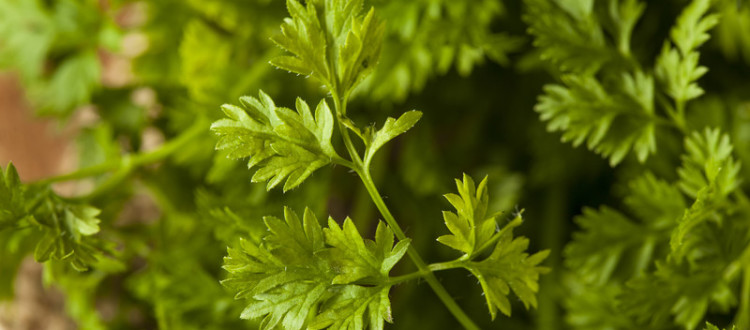Chervil
Chervil (Anthriscus cerefolium), sometimes called French parsley, is a delicate annual herb related to parsley. Its lacy, fern-like folige resembles a flat-leaved parsley, but its leaves are more finely dissected and paler green. Its unique scent and flavor are similar to the flavors of tarragon and fennel, although milder. Chervil is a component of fines herbes, an indispensable blend in French cooking.
How to Plant
Chervil thrives in cool, moist conditions and is best planted during the cooler growing seasons. In mild climates, chervil can be planted late summer to early fall for harvesting throughout the winter and spring. Chervil prefers a slightly acidic, loamy well-draining soil that retains moisture, so be sure to work in plenty of compost. Choose a semi-shaded location, such as between other plants, to help shield chervil from the heat of midsummer sun. Plant seedlings about 8 inches apart.
Fertilizing
Chervil is a light feeder. A month before planting time, work in aged manure and compost into the soil where you plan to grow chervil.
Pests and Diseases
Chervil is seldom bothered by any insect, fungus or disease problems. Aphids do like chervil but they are easy to wash off with a little water. Ladybugs are a natural predator of aphids and can be a natural way to control aphids all through your garden.
Slugs are an occasional problem, especially with younger plants. Keep a saucer of beer nearby to attract (and drown) them, or sprinkle the soil around your chervil plants with a little diatomaceous earth.
Watering your plants from above and wetting the leaves encourages powdery mildew (it looks like white dust) on your chervil. Instead, use a watering can with a spout, and pour the water underneath the plant on the soil.
Harvest and Storage
You can pick chervil leaves as you need them. For the best flavor, pick the outside leaves. To store it, refrigerate the leafy stems in a plastic bag with a damp paper towel, and they’ll keep for a week or more. For longer storage, you can either dry or freeze your chervil. Drying does have a tendency to lessen the flavor, so most people freeze their chervil for use through the winter.
Recommendations for Use
- Chervil is used in a number of cooked dishes but it loses its flavor very quickly when heated. Add fresh chervil at the last minute to your food.
- Chervil is one of the four ingredients in fines herbes, the classic French blend that also includes parsley, chives, and tarragon. To make your own blend, combine equal amounts of the each herb, minced.
- Use the herbs fresh to flavor vinaigrettes, omelets, softened cream cheese, herb butter, cooked carrots, chicken salad
- Chervil stars in béarnaise sauce, a variation of hollandaise.
- Use the fresh minded chervil leaves to enhance sole and other white fish, chicken, eggs and zucchini, as well as salads, sauces and soups.

